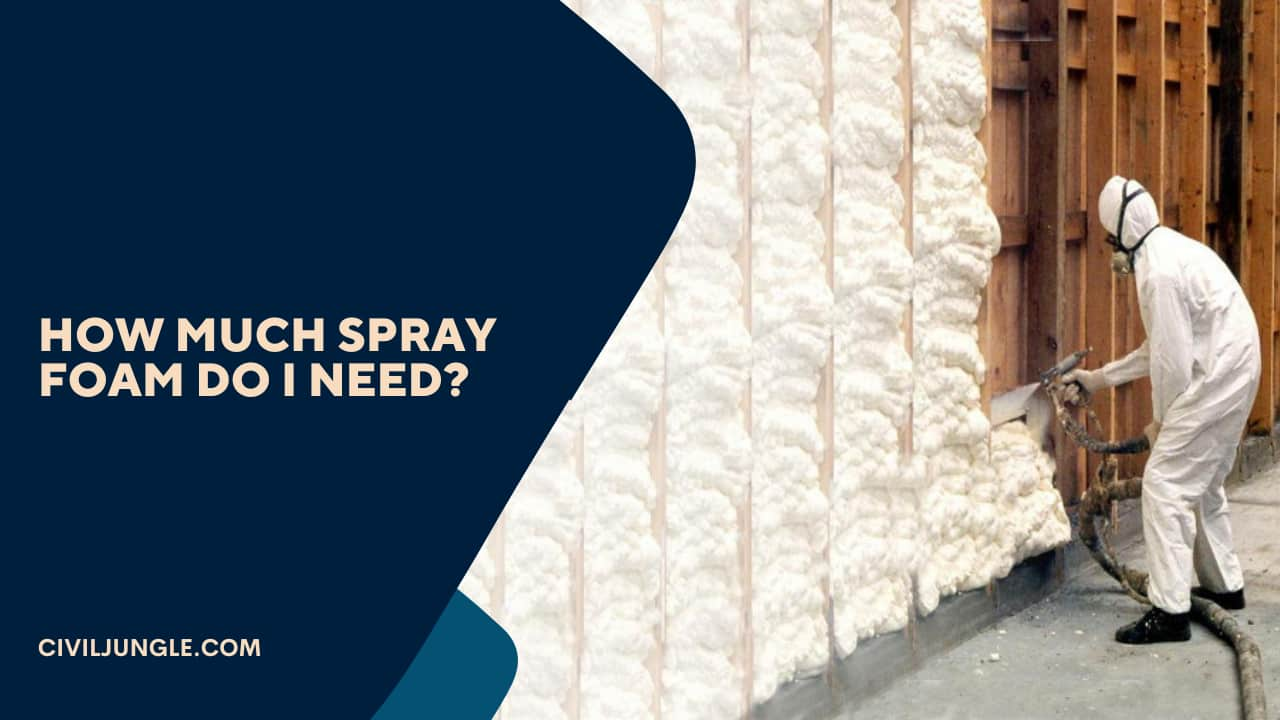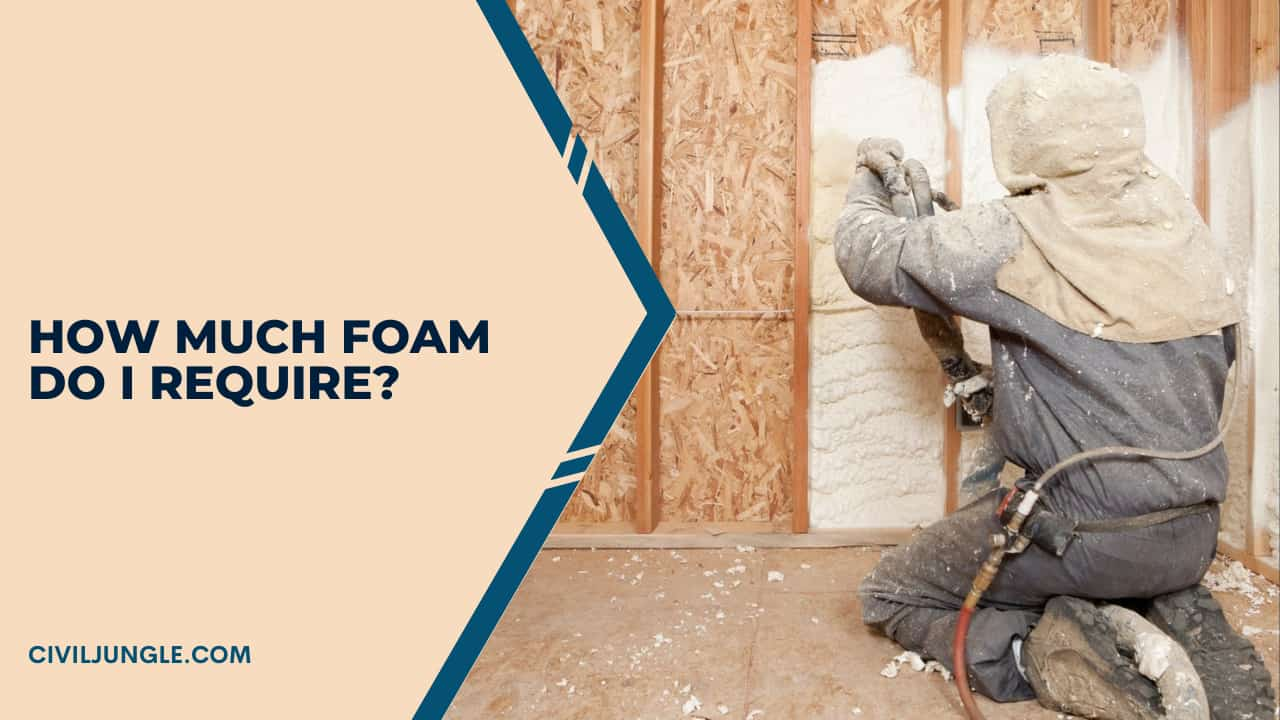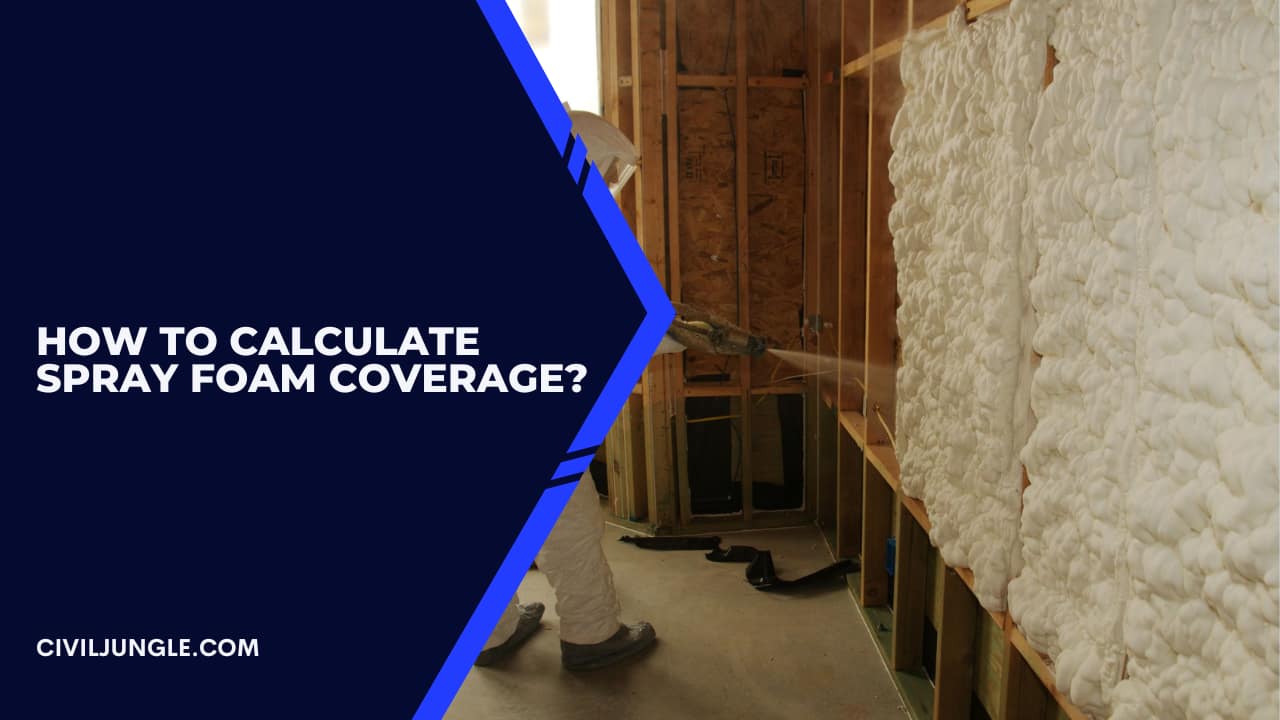How Much Spray Foam Do I Need?
Important Point
My home is 1500 cubic feet, how much spray foam covering do I require to deal with? We can’t replay this?
Because the cubic footage of the working place (normally the range of the ground) doesn’t tell us the range of the barriers, grounds, and beams that require to be covered.
But, we require to do some estimation to number out the range to be covered.
First some explanation
- Length: This is calculated in a right line (one size). Linear feet is a space of a right line calculated in feet.
- Range: This is a calculation of a figure that has the pair and thickness (two sizes), such as a cubic. For an easy figure, you differentiate the distance between the 2 sides.
Piece: Cubic Feet or Square Inches
- Size (volume): this is the calculation of a form that has length, thickness, and inch (three sizes). For an easy box, you different every three distances together.
- Piece: square feet inches
When operating with any of these make definitely that you have the matching piece for each of your calculations. If you have a blend of feet and height private everything to feet or height.
So Where to Begin?
View the structure you want to cover. Control totally which barriers, ground, or beam you want to try spraying too. We’re going to estimate the range of all outside and join them together to see how great the range wants to protect.
It has four barriers, 1 side is twelve ft. long and the other side is ten ft. long. But the full range of the ground is 10 ft. x 12 ft. which gives us 120 cubic feet (square foot) of floor range.
That’s big if we want to cover the floor, so we want to cover the barriers. Numbering out the range of the barriers.
Cover using long times area to estimate the floor range we require to view all parts of the barrier and calculate the range of all barrier parts singly.
Visualize that we can singly the barrier and place them level. We can then number out the range of all parts and join them together for a large total.
The cubic parts are simple, just different long times area (or in this instance long times inch) to get the range of that part.
So, delay not each barrier part is cubic, in that instance, it’s simple to break up the screen into a few parts and estimate all ranges.
For a barrier with a height, we break it into two parts, a figure and a three.
- The figure is long times inch, simple.
- The three, a small section more solid. Going back to that lower high geometry class, recall that the range of a three is ½ of a long time’s inch. Not so solid, is it?
- Barrier part size plan range
- Front twelve ft. x 12 ft. length x inch 144 cubics. Ft.
- Side base ten ft. x 12 ft. length x height 120 cubics. Ft.
- Peak (Three) ten ft. x 7 ft. 1/2(big x height) 35 cubic. Ft.
- Back 12 ft. x 12 ft. length x height 144 cubics. Ft.
- Side Base ten ft. x 12 ft. length x inch 120 sq. ft.
- Peak (Three) ten ft. x 7 ft. 1/2(length x height) 35 cubic. Ft.
- Total range = 598 cubics. Ft.
Our entire barrier range is 598 cubic feet. This adds windows and doors. Now clarify this a small. You don’t want to cover the windows and doors, do you?
To take away for the spaces that can’t cover, number the space of each of the windows and doors (just such as we just did for the barrier) and take away it from the above full.
I did this number out of our windows insulating 94 cubic feet of space.
- Barrier space-window space = space to be covered
- 5598 cubic. Ft. x 94 cubics ft. = 504 square ft.
- The full space we want to cover is 504 cubic ft.
Useful article for you
- How Much Does a Yard of Concrete Weigh
- How Tall Is a Door
- How Many Stairs in a Flight
- How Many Bags of Concrete in a Yard
- How to Get Burnt Smell Out of Microwave
- How Far Apart Should Fence Posts Be
- How Are Bridges Built Over Water
- How Many People Died Building the Great Wall of China
- How to Draw House
- How to Build a Lean to Roof
- How Many Bags of Concrete for 1 Yard
- How Much Does Cinder Block Cost
- How to Get a House for Free
- How Much Does It Cost to Soundproof a Room
- How to Read a Measuring Tape in Meters
- How to Mount a TV on a Brick Wall
- How Many Brick Are in a Cube
- How Is Transported Soil Different from Residual Soil
- How to Use Washers
- How to Get Property for Free
- How Is Tar Made
- How Much Does Gallon of Water Weight?
- How Many Tiles Do I Need?
- How Much Does It Cost to Build a Pergola?
- How Much Does a Concrete Slab Cost?
- How Much Does a Yard of Gravel Weigh?
- How Many Shingles Do I Need for a 24×24 Garage?
- How to Remove Paint from Concrete Without Chemicals
- How to Cover Concrete Walls in Basement
- How to Find Wall load
- How to Build a Cavity Wall
- How Much Does a Heated Driveway Cost
How Much Foam Do I Require?
If you view a spray foam tool like a big board froth Pak, you’ll overlook that it’s estimated to insulate so many cubic feet at one height thick.
This is what expect as a ”Dow foot”. Recall how we speak not to blend feet and height when making these estimations. With Dow’s feet, we avoid this.
To fix how much foam you’ll require, you require to expect two things, the space to be covered (cubic feet) and how thick you want your covered (heights).
Various the pair of these together and you the figure of board feet of cover that you require to purchase.
- To cover 1 height thick
- 504 cubic ft. x 1 in = 504 board feet
- To cover two heights thick
- 504 cubic ft. x two in = 1008 board feet
- For one inch of foam 1 big board froth Pak (650 board feet) will insult our structure with a small leftover.
- For two inches of foam. 1 big board froth Pak 650 and two Dow froth Pak 210’s (650+210+210=1070 board feet) should job.
Some Relate “Wall” Article Are as follows.
- Frost Wall
- Pony Wall
- Cmu Wall
- Parapet Wall
- Internal Wall
- What Is Drywall
- Wall Paint Finishes
- Sand Concrete Walls
- Gabion Wall Cost
- What Is a Shear Wall
- Types of Partition Wall
- Alternatives to Drywall
- Mount TV on Brick Wall
- Footing for Retaining Wall
- Disadvantages of Wall Putty
- Weep Holes in Retaining Wall
- Pros and Cons of Sealing Brick
- Hanging Picture on Brick Walls
- Bathroom Half Wall Panels
- Long Wall Short Wall Method
- Do Concrete Walls Need Insulation
- Does a Retaining Wall Need a Footing
- Cost to Repair Drywall Ceiling Water Damage
How to Calculate Spray Foam Coverage?
Householders’ and builders’ similarities can be checked when it comes to designing spray foam ranges. On the test, each figure may view complex, so the estimate is fully simple when you take it to step by step.
Here’s how to estimate spray foam privacy coverage and some advice for bettering your spray foam appeal coverage.
As a spray foam builder, it is big to expect the range of spray foam lining coverage before going into an estimate.
Knowing how much space to know is key to arranging enough spray foam for the work.
It’s also friendly to expect assistance regarding what type of home you will be spraying. This assists you suggest the top type of spray foam coverage for the work.
Expecting what piece of a structure you’ll be covering is also key to the advance of the project, as a sure situation like wetness and climate can affect pray foam appearance.
If you’re examining the area yourself or getting details from a buyer, begin by getting a calculation of the space.
Take the big inch of all the different barrier that requires coverage.
Next, calculate any spaces in the area that you won’t be covered. Like doors, windows, and screen studs.
Next, it’s time to do a small calculation:
- Take the big inch of all barriers and different these calculations to find the space in cubic feet. Join the cubic feet of all barriers to find your full space.
- Control the window, door, and covered space using the matching big different-by-inch estimation.
- Completely take away the window, door, and covered space from your full space to consider the coverage space.
- From here, it will be easy to control how much foam you require per cubic foot of insulation space.
How Much Spray Foam Insulation Do I Need?
Subtract the square feet of doors and windows in that wall. Subtract 6% for the studs (which you won’t be spraying) Take that total and multiply by 3.5″ for a 2″x 4″ wall, or 5.5″ if it is a 2″x 6″ wall. The result is the number of board feet you need to install to complete your project.
How Many Inches of Spray Foam Insulation Do I Need?
Now generically speaking, we usually recommend open cell spray foam to be 6- to 10-inches on a roof deck or ceiling and 3-inches in the walls. Closed cell spray foam should be 4- to 5- inches on the ceiling and 2- to 3-inches in the walls.
How Much Foam Insulation Do I Need?
To determine how much foam you’ll need, you need to know 2 things, the area to be insulated (square feet) and how thick you want your insulation (inches). Multiply both of these together and you get the number of board feet of insulation that you need to buy.
How to Calculate Spray Foam Coverage?
Calculating how much you need:
- Measure your outside walls length x height to get your raw square feet of wall area.
- Measure the doors and windows and get the total square feet of door and window area.
- Subtract window and door area from the total wall area.
- Subtract 10% from this figure to account for stud space.
Spray Foam Temperature
In storage, neither open cell nor closed cell spray foam should be stored above 90 degrees Fahrenheit. Spray foam insulation of any type should not be applied to a substrate or in an air temperature above 120 degrees Fahrenheit.
Spray Foam Insulation Moisture Problems
Mold and mildew can begin growing behind the insulation which can go unnoticed until it’s already become a huge problem. This often happens when the spray foam isn’t installed correctly and space is left between the insulation and the wall, which allows moisture in and gives mold the perfect place to grow, unfettered.
Roof Insulation Foam Benefits
What are the Major Benefits of a Spray Foam Roofing System?
- Seamless Waterproofing Around All Roof Equipment and Penetrations.
- Custom Insulation and Slope.
- Cool Roof Technology – Reduce Peak Power Demand, Lower Cooling Costs, Reduce Urban Heat Islands.
- Energy Efficient – Reduce Heating and Cooling Costs.
Benefits of Spray Foam Insulation
7 Main Benefits of Closed Cell Spray Foam Insulation
- Powerful Insulator.
- Incredible Energy Saver.
- Air Tight Seal.
- Moisture Barrier.
- Deters Mold.
- Long Life Span.
- Eco- Friendly.
What Does Expanding Foam Do?
Expanding foam can be defined as a two-component mixture composed of two materials that react when mixed. This causes the foam to expand and harden, providing an insulating material. Expanding foam insulation can be applied to any surface that needs to be reinforced to prevent draughts and enhance structural integrity.
What Is Spray Foam Insulation Used For?
Spray polyurethane foam (SPF) is a spray-applied plastic that is widely used to insulate buildings and seal cracks and gaps, making the building more energy-efficient and comfortable.
What Does Insulation Foam Do?
Insulating foam provides effective thermal insulation, as well as very good levels of acoustic insulation. That means that wherever you install insulating foam in your home, be that in the walls or the roof, for example, you’ll stop heat energy and sound energy from travelling both in and out.
How Does Spray Foam Work?
When sprayed, the chemicals react and expand into a layer of foam that hardens into a dense insulating layer. The thick layer that is created means spray foam won’t lose its shape over time and will continue to protect your home from air leakage. 2 types of spray foam are available; open cell and closed cell.
How Spray Foam Works?
What is SPF & How Does it Work? SPF, a spray-applied cellular plastic, is made by mixing chemicals to create foam. Those chemicals react very quickly, expanding on contact to create foam that insulates, air seals and provides a moisture barrier.
How Is Spray Foam Insulation Applied?
Spray foam is literally sprayed out of a hose to cover the area to be insulated. The two chemicals mentioned above are mixed in the spraying process, and as the spray foam is applied it expands (closed cell spray foam, for example, expands substantially) and hardens into place.
How to Spray Foam a Ceiling?
There should be less to cover with a ceiling application because you are spraying down, not up. Once everything is covered, start spraying. Keep the coating even and get every bit of the ceiling, especially around lights and vents. The foam will fill all the voids and cracks and seal your ceiling against drafts.
Like this post? Share it with your friends!
Suggested Read –
Originally posted 2023-07-31 15:05:08.




Leave a Reply